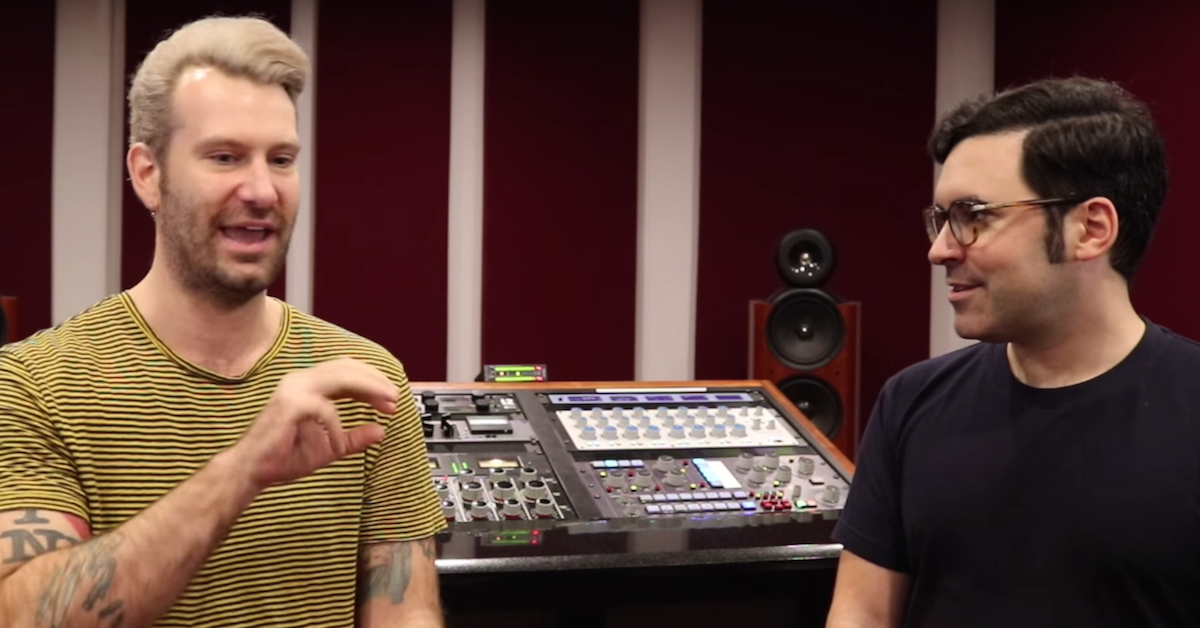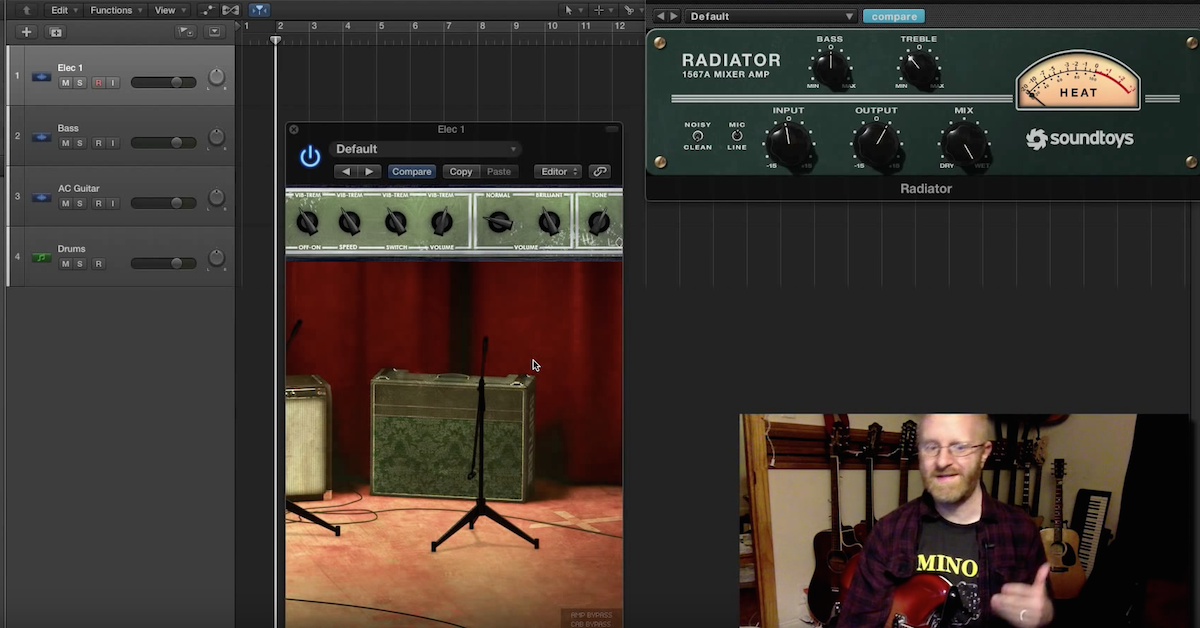How to Create a Pad Effect off Guitar Reverb with SoundToys Plugins
Specifically, I’ll be showing you how to take a simple guitar part and out of that, create an almost like a pad or synthesized sound. This type of effect is nothing new, it’s been around for awhile, made popular by guitarists like the edge from U2. What I’ll be doing is using reverb, delays, and modulation effects to accomplish this. Showing off a lot of the SoundToys plugins. Let me play you back what I came up with and then I’ll break it down one by one and show you how I created this sound.
[guitar pad effect]
Alright, hopefully that gives you an idea about what I’m doing for. First I’ll start off with the just simple guitar part and let you hear what it sounds like.
[dry electric guitar]
It’s very dry very boring on it’s own. First thing I’m gonna do is add in some reverb to it. So I’ve got an auxiliary send here, it’s going over to this reverb track. Sounds like this.
[guitar with reverb]
I’m using the stock DVerb plugin that comes with Pro Tools. Set it up on the church setting so I can have a long reverb time. Upwards towards 5 seconds. Just doing a little bit of spectral shaping after the reverb to get rid of some of the lows, some of the highs, give it a presence boost up here around 5k. Alright, that reverb sounds pretty good but on it’s own it’s not really gonna accomplish the full effect that I’m going for. S what I’m gonna do is set up another auxiliary send that comes just off my reverb. I’m gonna process my reverb with a bunch of different effects in parallel over here.
So first up, I’ve got modulation style effects. Gonna be passing my reverb here through the MicroShift by SoundToys. Dialed in, by kind of just tweaking one of the presets using Detuning and delay. This is gonna add some chorus movement to the reverb. Make it a little more dynamic rather than just a static reverb sound. So here’s what this plugin is adding in.
[guitar with reverb + eq + microshift]
So very nice modulation for this type of effect. Next up, using FilterFreak 2, using the preset called opposites attract. What this is gonna do is just add some resonant filters that are gonna accentuate certain peaks in my spectrum and have those change throughout the performance. Just to add a little bit of extra modulation.
[guitar with filterfreak]
This one I want to be definitely much more subtle with. Alright. Next up, PhaseMistress. This one here gonna do a little bit more movement. Thicken up the sound by adding some phase along with the reverb.
[guitar with phasemistress]
So here’s all the modulation effects together.
[guitar with all modulation effects]
Next up let me move on to the delay type of effects that I’m using. So I’m using reverb feeding into delays. First up is EchoBoy. Produces some analog type echo or delay using the preset called bucket brigade duel. I’ve just added a little bit more feedback. What this is gonna do is add reverb, or take my reverb, and add an echo to it or a delay to it. So really extend that reverb tail. You can hear what this one is gonna do.
[guitar with echoboy]
A modeled analog delay here is perfect for this kind of effect. Next up I’m gonna show you the PrimalTap. This one is great, it adds a little bit of extra wobble to the delays. You can hear here.
[guitar with little primaltap]
Very cool effect for what I’m trying to accomplish here. Last up I’ll show you the crystallizer plugin. This one I’m using the smooth crystals preset but I changed it a little bit. Turned the pitch up so it’s gonna create octave delays using, it’s a granular echo synthesizer so it’s gonna chop up the signal and create echo version of it, or delay versions of. You can hear what it’s gonna do. This one is adding a lot of top end sparkle and shine to my effect.
[guitar with crystalizer]
All the echo effects together.
[all guitar effects]
Alright, now everything back from the start. Alright that’s it guys. Hopefully you found this helpful. Showing you some creative ways of using effects on top of your reverb to make it much more dynamic and moving rather than just using a static reverb sound. I’d love to get your guys’ feedback on it. Please make comments below, I’ll get back to you guys. I’d love to hear other areas that you can use similar kinds of processing. Take care guys.
—
Overview:
Eric Tarr shows you how to make a static guitar reverb more interesting by layering SoundToys effects on top of it.
Plugins/Software:
– Avid Pro Tools
– SoundToys EchoBoy
– SoundToys Crystallizer Reverse Echo Effects
– SoundToys FilterFreak Resonant Analog Filter
– SoundToys Little PrimalTap
– SoundToys MicroShift
– SoundToys PhaseMistress
About SoundToys Plugins:
*EchoBoy*
When we designed EchoBoy, we were looking for an echo that was warmer than existing delay plug-ins, yet not as dark as guitar pedal echos. EchoBoy is now one of those ‘must-have’ plug-ins for Pro Tools, and has become a permanent fixture on the aux faders of thousands of top mixers and engineers.
*Crystallizer*
Inspired by the Crystal Echoes preset in the Eventide H3000, Crystallizer combines granular reverse echo slicing and retro pitch processing to create a huge range of radical sonic manipulations and classics with a twist. Use it to create synth-like textures from simple acoustic guitar rhythms, lush detuned echos, or completely psychedelic pitch-shifted reverse echo effects. Great for drums, guitar, bass, sound design, electronic music, and just about anything else – Crystallizer is a truly unique and creative effects processor.
*PhaseMistress*
Classic phase-shifting is a widely diverse sound. From the Bi-Phase, Boss Super Phaser, Phase 90, to the Moogerfooger 12 stage, Small Stone, Trine and many more. All of which were stacked in our test room, stock room and lining the halls. We needed to be sure PhaseMistress nailed that rich, warm, silky analog sound. We put in tons of styles to emulate all the classics and do some things those old boxes couldn’t do, like MIDI sync, and a large preset library. We think you’ll agree, PhaseMistress has got it all.
*Little PrimalTap*
Inspired by the classic Prime Time*, Little PrimalTap captures the highly distinctive sonic imprint of this quirky, and well-loved (by those in the know) vintage digital delay. Don’t be fooled by it’s simple interface, Little PrimalTap lets you unleash your creative urges to echo, loop, warp, distort, mangle, or create cacophonous cascades of otherworldly sounds.
*MicroShift*
MicroShift makes it wide. Be it vocals, synths, guitars, backing vocals or whatever you choose to run through it, MicroShift uses this classic studio trick to spread it out, thicken up, or give a new space to any track you hit with it.
*FilterFreak*
We’re big on analog. We think that sound is important. So we designed FilterFreak to be fat. To be warm. To be, well, analog. All the reviews and feedback say we got it. We also designed it to do all the things you do with filters. From funky envelope followers like Mutron, to classic synth style reshaping with ADSR, to big resonant LFO sweeps like the Sherman Filterbank, as well as the classic sound of the old Morley WahWah pedals. Even two flavors of the great old Sci-Fi sample and hold sound. But a plug-in needs to be more. So, we added a unique Rhythm Mode that lets you create cool custom patterns that lock to MIDI. A ll the fat and the flexibility of a whole closet full of filters and beyond.





